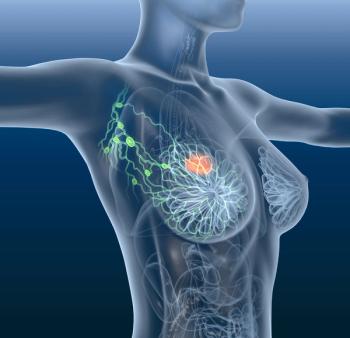
- ONCOLOGY Vol 11 No 9
- Volume 11
- Issue 9
Evidence at Molecular Level Supports Link Between Environmental Estrogens and Breast Cancer
Data from two studies presented at the 88th Annual Meeting of the American Association for Cancer Research (AACR)
Data from two studies presented at the 88th Annual Meeting of the AmericanAssociation for Cancer Research (AACR) have added evidence to support anassociation between environmental estrogens and breast cancer. Lifetimeexposure to endogenous estrogens is known to be a risk factor for breastcancer. However, there is uncertainty about whether environmental estrogenssuch as DDT are definitively linked to breast cancer. Two large epidemiologicalstudies conducted in the 1990s produced conflicting findings regardingthe correlation between increasing concentrations of DDT metabolites andincidence of breast cancer. Moreover, little is known about the potentialmechanisms by which endogenous or environmental estrogens convert normalbreast epithelial cells into abnormal cells.
Scientists from the Karmanos Cancer Institute in Detroit examined theeffects of estradiol and five closely related organochlorine pesticideson cell growth in two estrogen receptor-positive human breast epithelialcell lines: precancerous cells and human breast cancer cells. Organochlorinepesticides have been associated with the development of breast cancer becauseof their estrogenic properties. Those selected for this study act as estrogenswith actions mediated through the estrogen receptor.
Pesticide Combinations More Lethal
Using a special assay, the investigators found that when the pesticideswere administered individually, they caused the human breast epithelialcells to proliferate, but only when they were administered at 100- to 1,000-foldhigher levels than estradiol. However, when the pesticides were administeredin combination, they caused cell proliferation similar to that observedwith physiological concentrations of estradiol.
According to study investigator, Malathy Shekhar, PhD, "To date,there is no conclusive proof that endogenous estrogens cause breast cancer.The only evidence comes from epidemiological studies showing an associationbetween an individual's total cumulative exposure to estrogen and breastcancer. In order to provide stronger evidence for this association, westudied the possible mechanisms by which estrogens cause malignancy. Weused an estrogen receptor-positive precancerous cell line that we developed."
Dr. Shekhar added, "We found that estradiol and the pesticidesactivated estrogen-mediated responses via estrogen receptors on this cellline, suggesting that some environmental estrogens, particularly in combination,may be involved in breast cancer progression. This is an important findingbecause environmental estrogens such as DDT still pose a threat to humanseven though their use has been banned for many years. Not only does DDTremain in the environment for many years, but it also concentrates in adiposetissue in the breast and other organs in the body."
In a second study reported at the AACR Annual Meeting, researchers atthe University of Rochester School of Medicine and Dentistry investigatedwhether DDT isomers, different chemical forms of DDT, and their metabolitescan bind to and activate estrogen receptors in humans and act as estrogens.Results from previous studies had indicated that certain DDT compoundsspecifically bind to and activate rodent and avian estrogen receptors,but no data have been available on how these compounds interact with thehuman estrogen receptor at the molecular level.
Rat vs Human Receptors
Experiments conducted by researchers at the University of RochesterSchool of Medicine and Dentistry measured the ability of DDT isomers andmetabolites to bind to and activate the human estrogen receptor. The studiesfound that many of the DDT compounds had more than 100-fold higher affinitiesfor the human estrogen receptor than for the rat estrogen receptor. Usinga cellular model that expresses human estrogen receptors and provides ameasurable signal when this receptor is activated, the researchers screenedthe DDT compounds for estrogenic activity. They found that the DDT isomersand metabolites that bound to the human estrogen receptor were able toactivate it in a concentration-dependent manner and elicit an additiveresponse when administered with another DDT metabolite or with estradiol.
According to study investigator, Clarice W. Chen, MS, "Of particularsignificance is the finding that both DDT isomers bind to the human estrogenreceptor, whereas only one binds with measurable affinity to the rat estrogenreceptor. Moreover, many DDT metabolites have a substantially higher affinityfor the human than the rat estrogen receptor, even though the main metaboliteof DDT does not. Our data suggest the metabolites that activate the humanestrogen receptor do so with the same potency as the parent compounds,and this activation is additive to that of another DDT compound or estradiol.These findings differ from those using other animal models and suggestthat humans may be more susceptible to DDT metabolites than other species."
Articles in this issue
over 28 years ago
UFT: East Meets West in Drug Developmentover 28 years ago
Rationale for Phase I Study of UFT Plus Leucovorin and Oral JM-216over 28 years ago
Postoperative Adjuvant Chemotherapy for Non-Small-Cell Lung Cancerover 28 years ago
UFT in Gastric Cancer: Current Status and Future Developmentsover 28 years ago
Oral UFT and Leucovorin in Patients With Advanced Gastric CarcinomaNewsletter
Stay up to date on recent advances in the multidisciplinary approach to cancer.































































































